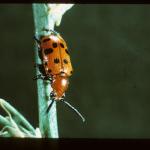Asparagus Beetle, Spotted
Crioceris duodecimpunctata
There are two beetle pests of asparagus, the common asparagus beetle and the spotted asparagus beetle. Distinguishing between the two species is important because while both beetles can damage the emerging spears, the common asparagus beetle larvae and adults can also devour the ferns. Significant defoliation can weaken the plant and reduce the plant’s ability to provide sufficient nutrients for the following season. Serious defoliation can also make asparagus more susceptible to invasion by plant pathogens. The feeding of spotted asparagus beetle larvae on berries does not affect the health of asparagus plants over the long run.
The spotted asparagus beetle originated in Europe, and spread throughout North America after it was introduced in the late 1800s.
Identification:
Spotted asparagus beetle (Crioceris duodecimpunctata) is reddish orange or tan, 6-8 mm long, with six black spots on each wing cover (hence its other name, 12-spotted asparagus beetle). It feeds only on asparagus, and tends to be less abundant than the common asparagus beetle, C. asparagi. Adults take flight quickly when disturbed. Eggs are greenish, glued singly on their sides to leaves and are laid on fronds, not on spears. Female plants with berries are preferred, and the widespread use of all-male hybrids that do not produce berries may have reduced populations. Larvae are pale yellow or orange, lighter in color than those of common asparagus beetle, plump, with a dark thorax. They feed almost entirely inside the berries, but need 2-4 berries to complete their growth, so may be found on fronds as they search for berries.
Life Cycle:
Spotted asparagus beetles overwinter as adults in field edges and in asparagus fields, usually in protected areas such as hollow asparagus stems and under bark. Although adults emerge in May (about 1 week later than common asparagus beetles) and move into fields to feed, egg-laying does not begin until ferns develop. Larvae feed on berries, then drop to the ground to pupate when they are fully grown.
Crop Injury:
Adults chew on emerging spears, creating small pits which make the spears unmarketable. However, populations are often too low to cause commercial damage. Later in the season, they feed on leaves and stems. Larvae only feed inside the berries, which affects seed production but does not hurt the plants.
Monitoring & Thresholds:
Begin scouting early in spring and continue through the summer. Scout for adults on sunny afternoons, when beetles are more active. Scout by sampling 10 plants in each of 5-10 different locations. Beetle distribution across the field tends to be clumped. Count adults, eggs, larvae, and take note of the damage to each plant. Consider treatment if >10% of the spears are infested with beetles (1 or more per plant) or 1-2% have eggs or damage. Treat ferns if 50-75% are infested.
Cultural Controls & Prevention:
- Grow all-male hybrids that do not produce berries, or eliminate female plants and thus berries.
- During harvest, harvest all spears every day to reduce the number of stems where eggs will survive for long enough to hatch or where larvae can feed and grow into summer-generation beetles.
- Disk old ferns lightly in the fall and clean up crop edges to reduce overwintering sites.
- Maintain clean environment in asparagus fields in the fall to force adults to overwinter in field edges where natural predators reside.
- Allow plants in one area to develop ferns so as to act as a trap crop. These plants can then be sprayed selectively.
Biological Controls:
A tiny (< 1/8 inch ) metallic green wasp, Tetrastichus asparagi (Hymenoptera: Eulophidae), parasitizes asparagus beetle eggs. These may be observed during scouting. They have been known to provide very effective control, parasitizing up to 70% of the eggs. Lady beetle larvae and other predators may also be active; they will consume both eggs and larvae as well as asparagus aphids. Use selective insecticides to preserve these natural enemies.
Chemical Controls & Pesticides:
Daily harvest of asparagus makes chemical treatment difficult. 1 dh products are available and can be used immediately after picking to allow harvest the following day (see the New England Vegetable Management Guide for current recommendations) although some growers seek to avoid applications during harvest. More selective products may be used on fronds after harvest.
Organic options on spears include Surround WP as a repellent, EC5.0, or products containing capsaicin (check for certification status).
If possible spot spray along edges of planting where overwintering adults colonize the field and/or band insecticide over the row to help spare natural enemies. Use selective insecticides on ferns.
Crops that are affected by this insect:
--R. Hazzard. References: Handbook of Vegetable Pests by John Capinera; 2008-2009 New England Vegetable Management Guide; Eric Sideman, MOFGA; Brian Caldwell, Cornell Universtiy, Suzanne Wold-Burkness and Jeffrey Hahn, UMI Department of Entomology.
The Center for Agriculture, Food and the Environment and UMass Extension are equal opportunity providers and employers, United States Department of Agriculture cooperating. Contact your local Extension office for information on disability accommodations. Contact the State Center Director’s Office if you have concerns related to discrimination, 413-545-4800 or see ag.umass.edu/civil-rights-information.
